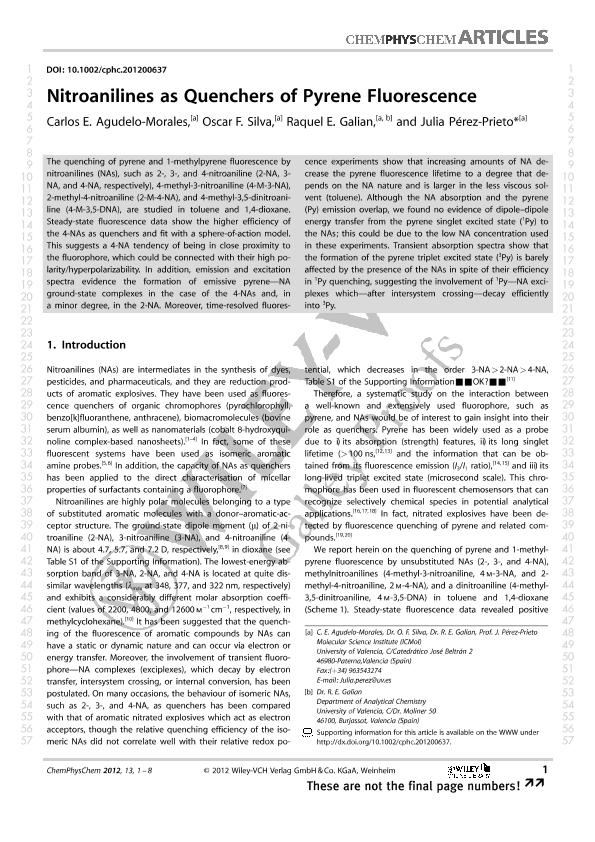Mostrar el registro sencillo del ítem
dc.contributor.author
Agudelo Morales, Carlos E.
dc.contributor.author
Silva, Oscar Fernando

dc.contributor.author
Galian, Raquel Eugenia

dc.contributor.author
Pérez Prieto, Julia
dc.date.available
2018-10-10T17:06:26Z
dc.date.issued
2012-12
dc.identifier.citation
Agudelo Morales, Carlos E.; Silva, Oscar Fernando; Galian, Raquel Eugenia; Pérez Prieto, Julia; Nitroanilines as Quenchers of Pyrene Fluorescence; Wiley VCH Verlag; Chemphyschem; 13; 18; 12-2012; 4195-4201
dc.identifier.issn
1439-4235
dc.identifier.uri
http://hdl.handle.net/11336/62074
dc.description.abstract
The quenching of pyrene and 1‐methylpyrene fluorescence by nitroanilines (NAs), such as 2‐, 3‐, and 4‐nitroaniline (2‐NA, 3‐NA, and 4‐NA, respectively), 4‐methyl‐3‐nitroaniline (4‐M‐3‐NA), 2‐methyl‐4‐nitroaniline (2‐M‐4‐NA), and 4‐methyl‐3,5‐dinitroaniline (4‐M‐3,5‐DNA), are studied in toluene and 1,4‐dioxane. Steady‐state fluorescence data show the higher efficiency of the 4‐NAs as quenchers and fit with a sphere‐of‐action model. This suggests a 4‐NA tendency of being in close proximity to the fluorophore, which could be connected with their high polarity/hyperpolarizability. In addition, emission and excitation spectra evidence the formation of emissive pyrene—NA ground‐state complexes in the case of the 4‐NAs and, in a minor degree, in the 2‐NA. Moreover, time‐resolved fluorescence experiments show that increasing amounts of NA decrease the pyrene fluorescence lifetime to a degree that depends on the NA nature and is larger in the less viscous solvent (toluene). Although the NA absorption and the pyrene (Py) emission overlap, we found no evidence of dipole–dipole energy transfer from the pyrene singlet excited state (1Py) to the NAs; this could be due to the low NA concentration used in these experiments. Transient absorption spectra show that the formation of the pyrene triplet excited state (3Py) is barely affected by the presence of the NAs in spite of their efficiency in 1Py quenching, suggesting the involvement of 1Py—NA exciplexes which—after intersystem crossing—decay efficiently into 3Py.
dc.format
application/pdf
dc.language.iso
eng
dc.publisher
Wiley VCH Verlag

dc.rights
info:eu-repo/semantics/openAccess
dc.rights.uri
https://creativecommons.org/licenses/by-nc-sa/2.5/ar/
dc.subject
Pireno
dc.subject
Fotoquimica
dc.subject
Anilinas
dc.subject
Desactivacion
dc.subject.classification
Otras Ciencias Químicas

dc.subject.classification
Ciencias Químicas

dc.subject.classification
CIENCIAS NATURALES Y EXACTAS

dc.title
Nitroanilines as Quenchers of Pyrene Fluorescence
dc.type
info:eu-repo/semantics/article
dc.type
info:ar-repo/semantics/artículo
dc.type
info:eu-repo/semantics/publishedVersion
dc.date.updated
2018-09-18T16:15:20Z
dc.journal.volume
13
dc.journal.number
18
dc.journal.pagination
4195-4201
dc.journal.pais
Alemania

dc.journal.ciudad
Weinheim
dc.description.fil
Fil: Agudelo Morales, Carlos E.. Universidad de Valencia; España
dc.description.fil
Fil: Silva, Oscar Fernando. Universidad de Valencia; España
dc.description.fil
Fil: Galian, Raquel Eugenia. Universidad de Valencia; España
dc.description.fil
Fil: Pérez Prieto, Julia. Universidad de Valencia; España
dc.journal.title
Chemphyschem

dc.relation.alternativeid
info:eu-repo/semantics/altIdentifier/doi/https://dx.doi.org/10.1002/cphc.201200637
dc.relation.alternativeid
info:eu-repo/semantics/altIdentifier/url/https://onlinelibrary.wiley.com/doi/abs/10.1002/cphc.201200637
Archivos asociados
